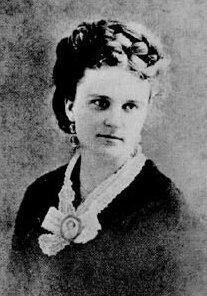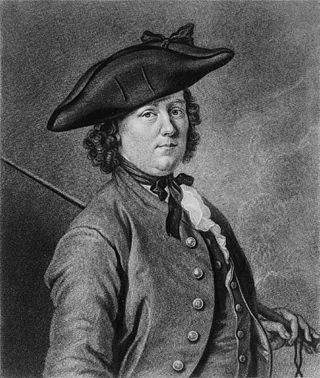
Kate Chopin was an American author of short stories and novels based in Louisiana. She is considered by scholars to have been a forerunner of American 20th-century feminist authors of Southern or Catholic background, such as Zelda Fitzgerald, and she is one of the more frequently read and recognized writers of Louisiana Creole heritage. She is best known today for her 1899 novel The Awakening.

Deborah Sampson Gannett, also known as Deborah Samson or Deborah Sampson, was born on December 17, 1760, in Plympton, Massachusetts. She disguised herself as a man, and served in the Continental Army under the name Robert Shirtliff – sometimes spelled Shurtleff or Shirtleff – and fought in the American Revolutionary War. She fought in the war for 17 months before her sex was revealed when she required medical treatment after contracting a fever in Philadelphia in 1783. After her real identity was made known to her commander, she was honorably discharged at West Point. After her discharge, Sampson met and married Benjamin Gannett in 1785. In 1802, she became one of the first women to go on a lecture tour to speak about her wartime experiences. She died in Sharon, Massachusetts, in 1827. She was proclaimed the Official Heroine of the Commonwealth of Massachusetts on May 23, 1983, and in 1985 the United States Capitol Historical Society posthumously honored "Deborah Samson" with the Commemorative Medal.

Mary Ludwig Hays was a woman who fought in the American War of Independence at the Battle of Monmouth. The woman behind the Molly Pitcher story is most often identified as Hays, but it is likely that the legend is an amalgam of more than one woman seen on the battlefield that day.

Margaret Cochran Corbin was a woman who fought in the American Revolutionary War. On November 16, 1776, her husband, John Corbin, was one of 2800 American soldiers defending Fort Washington in northern Manhattan from 8,000 attacking Hessian troops under British command. Margaret was too nervous to let her husband go into battle alone, so she decided she wanted to go with him. Since she was a nurse, she was allowed to accompany her husband as a nurse for injured soldiers. John Corbin was on the crew of one of two cannons the defenders deployed; when he fell in action, Margaret Corbin took his place and continued to work the cannon until she too was seriously wounded. It is said that Corbin was standing next to her husband when he fell during battle. Immediately, she took his post, and because she had watched her husband, a trained artilleryman, fire the cannon so much, she was able to fire, clean and aim the cannon with great ease and speed. This impressed the other soldiers and was the beginning of her military career. She later became the first woman in U.S. history to receive a pension from Congress for military service when she could no longer work due to injury, and was enlisted into the Corps of Invalids.

Mary Read, fictionally known as Mark Read, was an English pirate about whom there is very little factual documentation. She and Anne Bonny were two famous female pirates from the 18th century, and among the few women known to have been convicted of piracy at the height of the "Golden Age of Piracy".

Many people have engaged in cross-dressing during wartime under various circumstances and for various motives. This has been especially true of women, whether while serving as a soldier in otherwise all-male armies, while protecting themselves or disguising their identity in dangerous circumstances, or for other purposes.

Phoebe Hessel, née Smith was best known for disguising herself as a man to serve in the British Army, probably to be with her lover, Samuel Golding. She lived to the age of 108.

Soldaderas, often called Adelitas, were women in the military who participated in the conflict of the Mexican Revolution, ranging from commanding officers to combatants to camp followers. "In many respects, the Mexican revolution was not only a men's but a women's revolution." Although some revolutionary women achieved officer status, coronelas, "there are no reports of a woman achieving the rank of general." Since revolutionary armies did not have formal ranks, some women officers were called generala or coronela, even though they commanded relatively few men. A number of women took male identities, dressing as men, and being called by the male version of their given name, among them Ángel Jiménez and Amelio Robles Ávila.

Flora Sandes was a British woman who served as a member of the Royal Serbian Army in World War I. She was the only British woman officially to serve as a soldier in that war. Initially a St John Ambulance volunteer, she travelled to the Kingdom of Serbia, where she was welcomed and formally enrolled in the Serbian army. She was subsequently promoted to the rank of sergeant major, and, after the war, to senior captain. She was decorated with seven medals.

Mary Wollstonecraft Shelley was an English novelist who is best known for writing the Gothic novel Frankenstein; or, The Modern Prometheus (1818), which is considered an early example of science fiction. She also edited and promoted the works of her husband, the Romantic poet and philosopher Percy Bysshe Shelley. Her father was the political philosopher William Godwin and her mother was the philosopher and women's rights advocate Mary Wollstonecraft.

Wife selling is the practice of a husband selling his wife and may include the sale of a female by a party outside a marriage. Wife selling has had numerous purposes throughout the practice's history; and the term "wife sale" is not defined in all sources relating to the topic.
Prudence "Pru" Cummings Wright was a militia commander during the American Revolutionary War.
This is a timeline of women in warfare in the United States up until the end of World War II. It encompasses the colonial era and indigenous peoples, as well as the entire geographical modern United States, even though some of the areas mentioned were not incorporated into the United States during the time periods that they were mentioned.
Charles Henry St. John Cooper was a prolific English novelist of school and adventure fiction. He wrote thousands of stories for several Amalgamated Press papers, sometimes under the pen name Mabel St. John. He is perhaps best known for creating, in 1908, the character Pollie Green, considered the "most popular, though not the first, in a series of irrepressible schoolgirl heroines". According to his son, he also wrote many "authorless" Sexton Blake stories for the Union Jack. His novel Sunny Ducrow was adapted into a 1926 film, Sunny Side Up.

Sally Jane Brampton was an English journalist, writer, and magazine editor. She was the founding editor of the British edition of the French magazine Elle in 1985.
Anna Maria Lane was the first documented female soldier from Virginia to fight with the Continental Army in the American Revolutionary War. She dressed as a man and accompanied her husband on the battlefield, and was later awarded a pension for her courage in the Battle of Germantown.

Anastasia Alekseevna Bitsenko, née Kameristaya was a Narodnik-inspired, later Communist, Russian revolutionary. As a member of a socialist revolutionary (SR) flying combat detachment, she came to fame for assassinating the former Russian Minister of War Viktor Sakharov in 1905. After being held in detention for over 11 years, she was freed during the February Revolution and joined the Left Socialist-Revolutionaries. For her achievements, the party designated her as their representative within the Soviet delegation for the German-Russian peace negotiations in World War I, which resulted in the Treaty of Brest-Litovsk. She eventually sided with the Soviet regime for good, adhering to the Communist ideology.

Mary Eva Hastings Morris was a Welsh medical doctor and suffragist. Born in Dolgellau, she grew up in Malta, before returning to Wales to study medicine at the University College of Wales in Aberystwyth. She went on to become the first female doctor from Aberystwyth. After spells working at Great Ormond Street Children's Hospital in London, the North Devon Infirmary, and Bristol Royal Hospital for Sick Children and Women, Morris moved to Bath, where she worked as a medical inspector.

Irina Konstantinovna Kakhovskaya was a Narodnik-inspired Russian revolutionary. Grandniece of the Decembrist Pyotr Kakhovsky, she was a representative of the Left Socialist-Revolutionaries during the Russian Revolution: in 1918 she organized the assassination of Field Marshal Hermann von Eichhorn, commander of the German occupation forces in Ukraine. In total she spent forty-five years of her life in prison and exile, both under the Tsarist and Soviet regimes, as well as briefly at the end of World War I in German military jail.















